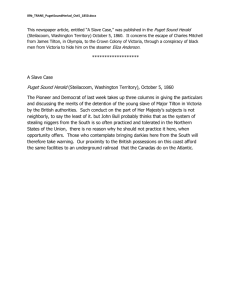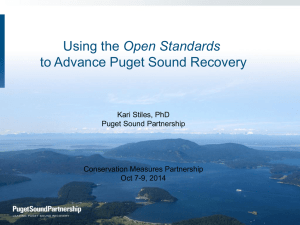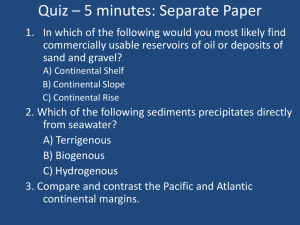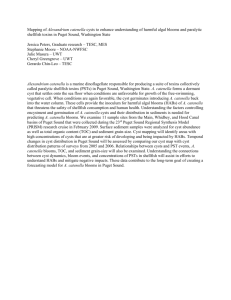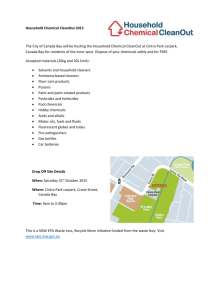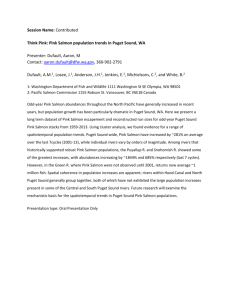Report-2013-PPCP-PFAS-Elliott-Bay-12-16-14-near
advertisement
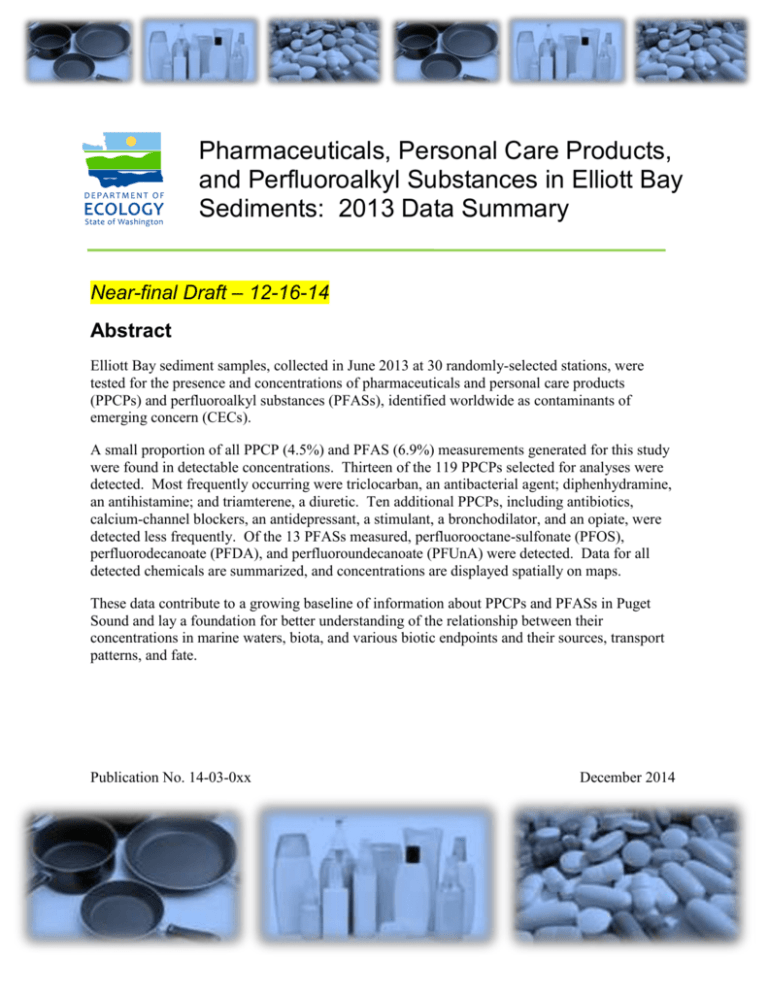
D e p a r t m e n t o f E c o l o g y R e p o r t Pharmaceuticals, Personal Care Products, and Perfluoroalkyl Substances in Elliott Bay Sediments: 2013 Data Summary Near-final Draft – 12-16-14 Abstract Elliott Bay sediment samples, collected in June 2013 at 30 randomly-selected stations, were tested for the presence and concentrations of pharmaceuticals and personal care products (PPCPs) and perfluoroalkyl substances (PFASs), identified worldwide as contaminants of emerging concern (CECs). A small proportion of all PPCP (4.5%) and PFAS (6.9%) measurements generated for this study were found in detectable concentrations. Thirteen of the 119 PPCPs selected for analyses were detected. Most frequently occurring were triclocarban, an antibacterial agent; diphenhydramine, an antihistamine; and triamterene, a diuretic. Ten additional PPCPs, including antibiotics, calcium-channel blockers, an antidepressant, a stimulant, a bronchodilator, and an opiate, were detected less frequently. Of the 13 PFASs measured, perfluorooctane-sulfonate (PFOS), perfluorodecanoate (PFDA), and perfluoroundecanoate (PFUnA) were detected. Data for all detected chemicals are summarized, and concentrations are displayed spatially on maps. These data contribute to a growing baseline of information about PPCPs and PFASs in Puget Sound and lay a foundation for better understanding of the relationship between their concentrations in marine waters, biota, and various biotic endpoints and their sources, transport patterns, and fate. Publication No. 14-03-0xx December 2014 1 Publication Information This report is available on the Department of Ecology’s website at https://fortress.wa.gov/ecy/publications/SummaryPages/1403049.html Data for this project are available at Ecology’s Environmental Information Management (EIM) website www.ecy.wa.gov/eim/index.htm. Search Study IDs: PSAMP_SP, UWI2013. Ecology’s Activity Tracker Code for this study is 01-900. Water Resource Inventory Area (WRIA) and 8-digit Hydrologic Unit Code (HUC) numbers for the study area: WRIA 09 HUC numbers 17110013 17110019 Contact Information Authors: Margaret Dutch, Sandra Weakland, Valerie Partridge, Kathy Welch Marine Monitoring Unit Environmental Assessment Program P.O. Box 47600 Olympia, WA 98504-7600 Communications Consultant Phone: (360) 407-6764 Washington State Department of Ecology - www.ecy.wa.gov/ o Headquarters, Olympia (360) 407-6000 o Northwest Regional Office, Bellevue (425) 649-7000 o Southwest Regional Office, Olympia (360) 407-6300 o Central Regional Office, Yakima (509) 575-2490 o Eastern Regional Office, Spokane (509) 329-3400 Accommodation Requests: To request ADA accommodation including materials in a format for the visually impaired, call Ecology at 360-407-6764. Persons with impaired hearing may call Washington Relay Service at 711. Persons with speech disability may call TTY at 877-833-6341. 2 Background In recent years, a diverse group of relatively unmonitored and unregulated chemicals found in consumer and industrial products has been shown to occur at trace levels in wastewater discharges, ambient receiving waters and sediments, drinking water supplies, and biotic tissue samples collected in and near large estuaries. When discharged to the environment, these “contaminants of emerging concern (CECs)” have the potential to cause adverse toxicological, biological, and ecological effects to both wildlife and humans (Diamond et al., 2011). Two groups of CECs of interest to scientists working in large estuarine and freshwater systems worldwide, including Puget Sound, are pharmaceuticals and personal care products (PPCPs) and perfluoroalkyl substances (PFASs). PPCPs include thousands of prescription and over-thecounter drugs, nutritional supplements, shampoos and lotions used by humans, as well as drugs administered to livestock. PFASs include chemicals with non-stick, water-repellant, and stainresistant properties and are used in the manufacture of clothing, carpeting, cookware, and other products. After PPCPs are consumed and as products containing PFASs wear, the chemicals find their way into the aquatic environment through both point-source and nonpoint-source pathways (Kummerer, 2004; Buck et al., 2011). Over the past decade, PPCPs have been found in measurable concentrations in wastewater treatment plant influent and effluent in Washington (Puget Sound and other water bodies) and Oregon (Hope, 2012; Johnson et al., 2004; Lubliner et al., 2010; Morace, 2012), reclaimed water (Johnson and Marti, 2012), and surface water and groundwater (Dougherty et al., 2010). Biological effects due to exposure to estrogenic and endocrine-disrupting chemicals have been observed in Puget Sound fish (Johnson et al., 2008; Peck et al., 2011; daSilva et al., 2013). PPCPs have also been measured in sediments collected in Bellingham Bay and other Puget Sound locations (Long et al., 2013) and in sediments from the Columbia River and selected tributaries (Nilsen et al., 2007). Perfluoroalkyl substances have been detected in surface water, fish tissue, and osprey eggs in and around Washington rivers and lakes, five of which drain into Puget Sound (Furl and Meredith, 2010). These chemicals have also been found in sediments collected in Bellingham Bay and other Puget Sound locations (Long et al., 2013). CEC Monitoring Priority for Puget Sound: PPCPs and PFASs in Urban Bay Sediments Characterization of sources, transport patterns, and fates of CECs in the Puget Sound ecosystem was recently prioritized in the Puget Sound Action Agenda as part of the toxics monitoring strategy for Puget Sound (Puget Sound Partnership, 2012). As part of this strategy, the Washington State Department of Ecology (Ecology) Marine Sediment Monitoring Team (MSMT) received funding through the US Environmental Protection Agency (USEPA) National Estuary Program (NEP) to measure concentrations of PPCPs and PFASs in Elliott Bay sediments. 3 The measurement of these chemicals in Elliott Bay sediments in June 2013 was conducted as part of the Puget Sound Ecosystem Monitoring Program (PSEMP) Sediment Component and followed a survey conducted in 2010 which successfully established a baseline data set for these CECs in Bellingham Bay and at 10 long-term sediment monitoring stations throughout Puget Sound (Long et al., 2013). Continued establishment of baseline concentrations of these chemicals in Puget Sound is a first step toward understanding the distribution of these chemicals and their potential impact on humans and aquatic biota, and is necessary for future management and regulation of these chemicals in the Puget Sound ecosystem. Study Objectives The objectives of this study of Elliott Bay sediments were to: Establish a baseline record of concentrations for 119 PPCPs and 13 PFASs in Elliott Bay sediments. Provide high quality sediment CEC data to the Puget Sound ecosystem community of scientists, managers, and regulators. Compare PPCP and PFAS concentrations among Puget Sound urban bays. The third objective, comparison of sediment PPCP and PFAS data from this Elliott Bay survey to data from sediment surveys elsewhere in Puget Sound, will be summarized in a separate report upon completion and review of chemical analyses from 2014. 4
